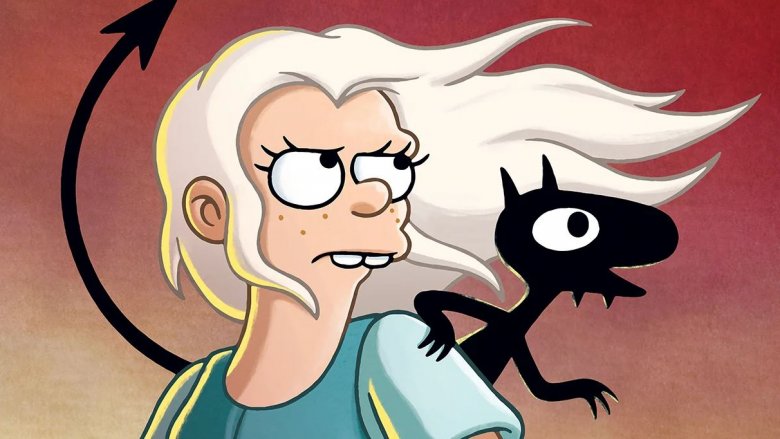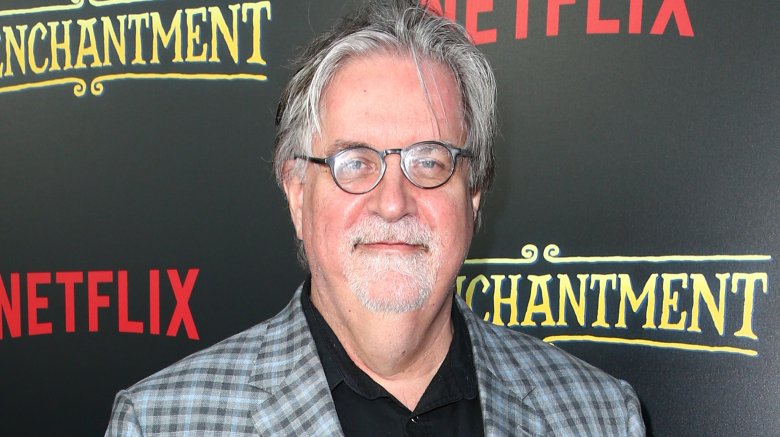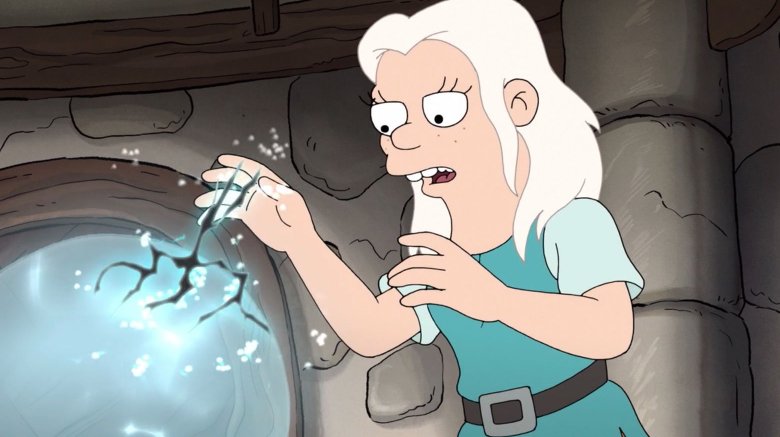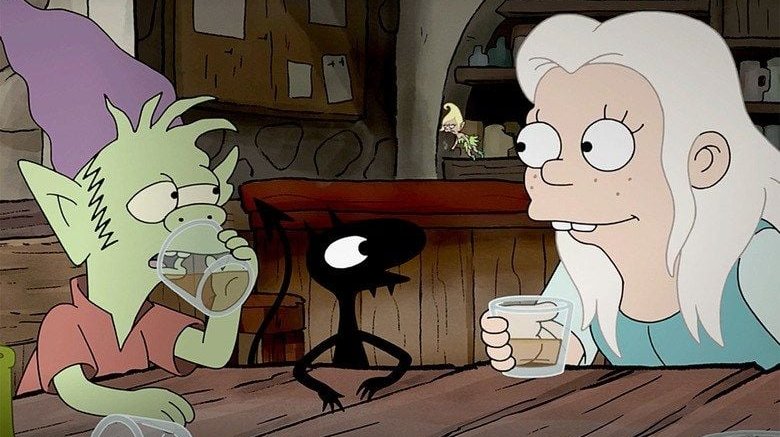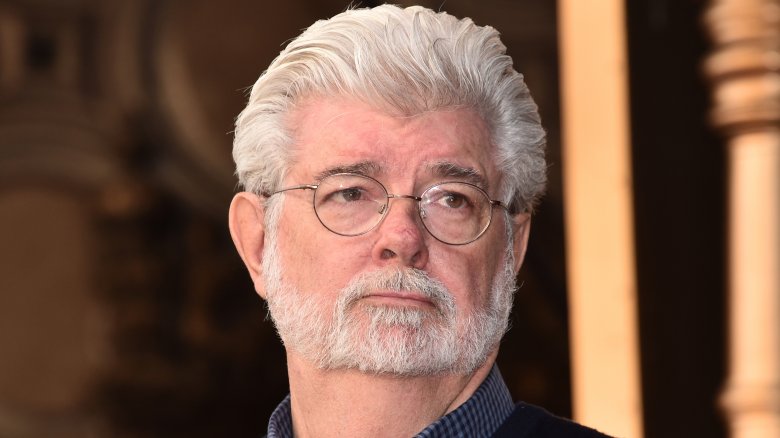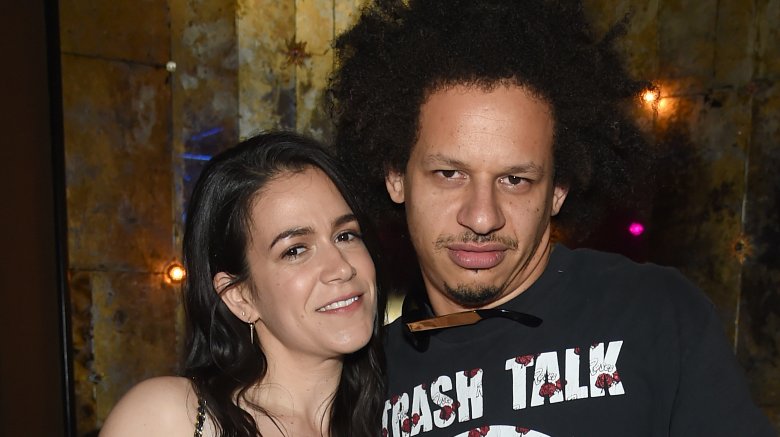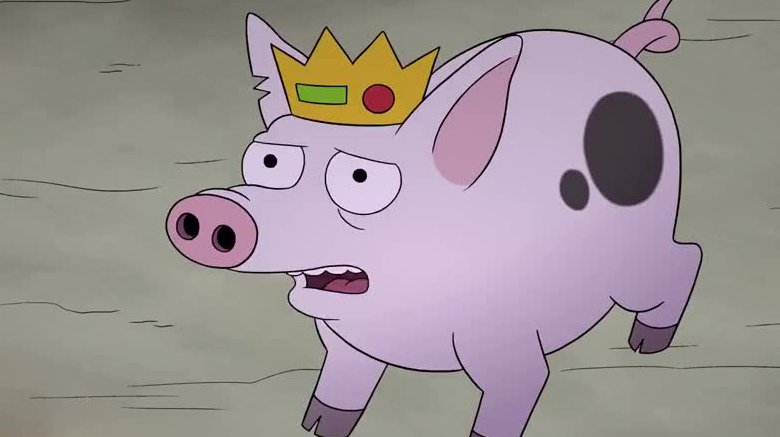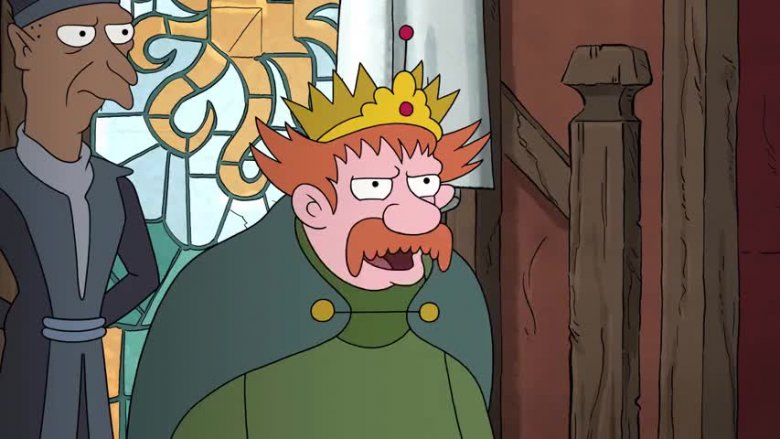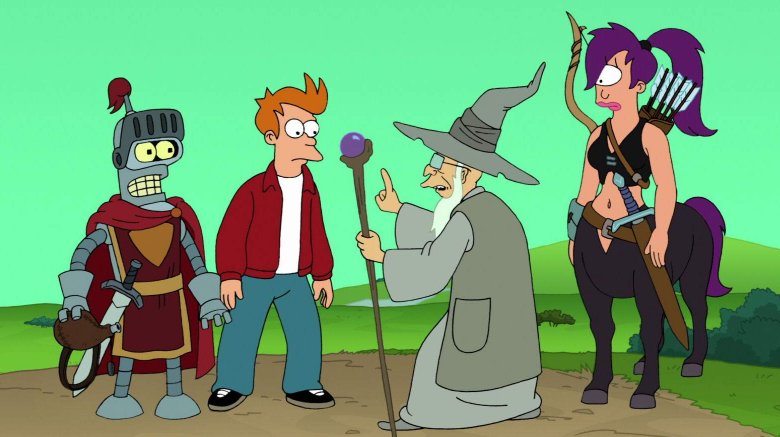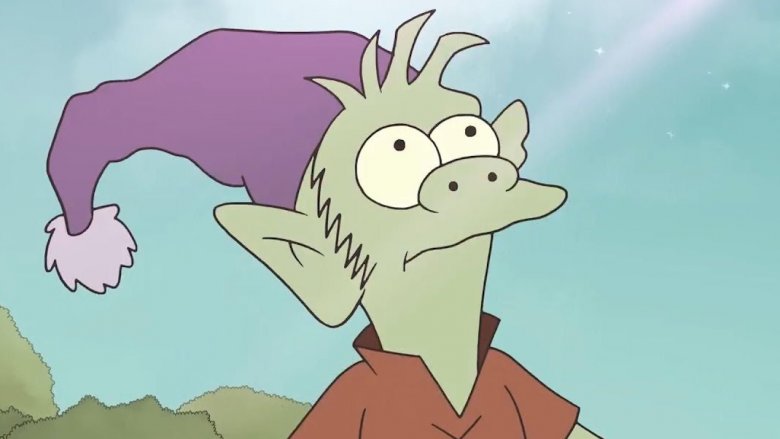The Untold Truth Of Disenchantment
After creating a show set in the present (The Simpsons) and one set in the future (Futurama), cartoonist Matt Groening decided to head back into the past with Disenchantment. Premiering on Netflix in the summer of 2018, Disenchantment takes place in the medieval kingdom of Dreamland and thereabouts, a richly rendered and well-developed fairy tale world populated by elves, sorcerers, fish queens, put-upon peasants, heartless royals, and invading hordes.
And then, of course, there's Princess Tiabeanie, or rather Bean, an alcoholic princess who'd much rather have a good time than have anything to do with her responsibilities in the castle. She bristles at the expectations of her father, the crude and selfish King Zøg who's barely holding together a realm that's very much past the "happily ever after" phase. Princess Bean is joined in her adventures by her personal demon, Luci, and a happy-go-lucky elf named Elfo who might have magical blood.
But that's all stuff we see on the screen. What's going on behind the scenes? How did Disenchantment make its way to Netflix? How many Easter eggs are hidden throughout the show? And how did the cast wind up providing voices for these crazy character? Well, let's go back long ago and far away for this heroic journey into the untold truth of Disenchantment.
Matt Groening devised this story long ago
Disenchantment's roots stretch back 50 years. "Back in high school, I used to draw a little comic strip for my friends, called Tales of the Enchanted Forest," Groening told Global News, adding that when he was a kid, he read a startling psychoanalysis of fairy tales. "The author pointed out that the evil stepmother wasn't really the stepmother, but instead the stand-in for the evil mother. I've always taken fairy tales seriously ever since."
The idea for a series coalesced much later. Futurama executive producer Claudia Katz told NPR's All Things Considered that Groening pitched "the idea of Disenchantment probably in the second or third season of Futurama." Groening said it took 20 years to get the series off the ground "because animation is too darn hard to do." During the show's creation phase, he kept rejecting animators' mock-ups. As Katz explained, "Matt just kept going, 'No, no, no, no, no,' it's gotta be a lot more cinematic."
Ultimately, Groening connected with The Simpsons, Futurama, and Gravity Falls veteran Josh Weinstein to get the show to air (or streaming, as it were). That took a while, too. "We've been developing it for the last three years," Weinstein told The Hollywood Reporter. "Matt's had this idea for years and years. He has these notebooks that are filled with drawings and various ideas." And all these years later, those ideas have finally made their way to the screen.
The Disenchantment writers are subverting fantasy fiction
Fantasy stories, for all of their enchantments and charm, tend to be pretty simplistic. Characters stay firmly in their narrow roles as a mighty hero or helpless princess. The good guys are 100 percent noble, and the villains are completely wicked. However, the creators of Disenchantment consciously aimed to subvert almost every expectation of fantasy fiction that they could. "The tendency in a lot of epic fantasies and science fiction is 'good vs. evil,' and we tried to shade it a little bit," Groening told Gamespot. For example, King Zøg "starts out pretty villainous, but then you find out he has his reasons, and he's not all bad."
That desire to mix it up affected the show's initial presume. "The very original conception was that Elfo was going to be the main character. And I thought first of all, he's an elf, and he's just not as interesting or relatable," co-creator Josh Weinstein told Decider. He wanted to focus on Princess Bean, but he didn't want her to be like a Disney or a warrior princess, but "like a real 19-year-old woman." Weinstein says he based her on friends from his formative years. "We drank too much, and we found the world very frustrating."
The story behind the show's characters
While co-creator Matt Groening had been tossing around the idea for a medieval fantasy series for a long time, some of the visuals remained unchanged even after years of development. "Elfo is based on the very first character I ever drew in this style in the fifth grade, and he looked almost exactly like that without the elf hat," Groening said at San Diego Comic-Con 2019 (via Den of Geek). However, as Groening explained, there was one problem. Elfo didn't look enough like an adult. "When we drew him first, and we wanted him to have romantic feelings towards Bean and towards other characters in the show, but he looked like a little kid." So what was the solution to indicate that Elfo was a grown-up with grown-up feelings? "We gave him sideburns," Groening said.
As for Luci — a character who's unsettling, jet black, and completely flat except for two big white eyes — he's one of the few characters in the show that didn't originate with Groening's fantasy doodles. "This is a character that I designed independently of the show," Groening said. "Obviously it's in a completely different style."
Disenchantment was inspired by George Lucas
Obviously, one of the biggest influences on Disenchantment is the vast canon of medieval-set fantasy literature. There's a lot of Lord of the Rings, King Arthur legends, and fairy tales present in the show's DNA, as well as elements of The Simpsons and Futurama, since co-creator Matt Groening had a hand in those shows, too. But Groening and Josh Weinstein didn't intend to make just some sarcastic and satirical swords-and-sorcery saga. "This show is a coming-of-age story with a backdrop of all this fantasy," Weinstein told The Hollywood Reporter. "So as much as it's like Futurama or Lord of the Rings, it's also like American Graffiti."
American Graffiti is best known as the hit movie from 1973 that made George Lucas a big name. Set in the last day of summer in 1962, the movie stars the likes of Ron Howard, Cindy Williams, Richard Dreyfuss, and Harrison Ford. As for the plot, it's an episodic, ensemble-driven story about teens skittishly sitting on the frightening precipice of adulthood and grappling with that idea. Similarly, Weinstein pointed out that Disenchantment is "a story of these three characters facing the world for the first time as an adult. All the adults and legends that come before tell you what you should do and how you should behave, but our characters are like, 'No, that's B.S. and we're going to find our own way.'"
The cast didn't think they'd be in the cast
While Disenchantment's supporting cast is stacked with animation veterans, including John DiMaggio, Billy West, and David Herman, two of the main roles are performed by relative newcomers to the voiceover world, both of whom are Millennial comedy icons. Abbi Jacobson, best known for her role as Abbi on Comedy Central's Broad City (a show she helped create), stars as Princess Bean. And then there's Eric Andre of Adult Swim's aggressively deconstructive The Eric Andre Show, who plays Luci, Bean's mischievous personal demon and companion. Despite their comedy bona fides, neither Jacobson nor Andre thought they'd be a good fit for Disenchantment.
"I got just an email from my agent," Andre told Decider about the show's casting call. "I saw Matt [Groening]'s name on the project, and I put it off for a while because I thought, 'I never book these things.' And then at the last moment, I recorded myself and self-submitted." Andre and Jacbson are good friends, but he had no idea that she was also up for a part on Disenchantment, or apparently, that she similarly harbored doubts. "I'm not a great auditioner, so I kind of forgot I did it, thinking I wasn't going to get it," Jacobson told Variety regarding her try-out for the series. "And then I got it."
Disenchantment is a very British cartoon
There are many English-accented characters in Disenchantment. This is a well-worn trope in fantasy films and television. Despite taking place in some magical, fictional kingdom whose location is unknown, the characters all seem to hail from England, where they took extensive theatrical training. Game of Thrones went down in Westeros, and Lord of the Rings in Middle-earth, and yet so many people speak like the Queen. This is true for Disenchantment, too, but the preponderance of British actors has nothing to do with this weird tradition. Instead, it's just business.
See, Disenchantment co-creator Josh Weinstein helped make the puppet show Strange Hill High for the BBC. He told The Hollywood Reporter that the show led "through a twisted path" to a pilot he made for Fox that starred Matt Berry and Rich Fulcher, but it didn't get picked up. Berry and Fulcher (who's American but made his name in the British comedy world) also happened to star on the surreal cult classic sitcom The Mighty Boosh, which Weinstein says is his "favorite show of all time." That series also involved comedian Noel Fielding in a big way, and thus he, along with Berry and Fulcher, found work on Disenchantment. Berry voices Prince Merkimer, Fulcher plays Turbish, and Fielding is behind Stan the Executioner.
The show is full of Easter eggs
A hallmark of every Matt Groening series is layers upon layers of jokes and references. Dialogue and sight gags alike allude to other media, or they're used to add even more humor to the proceedings, a regular feature of both The Simpsons and Futurama. Disenchantment is no different, packing even its first slate of episodes with plenty of treasures waiting to be discovered by attentive viewers.
For example, King Zøg wears a crown, as he's a king, but it's supposed to look like the floppy hat-crown thing worn by Jughead in Archie Comics. When Princess Bean enters a wig shop, she passes by a prominently displayed mannequin head bearing an orange hairpiece styled in the exact same way as Fry did his up on Futurama. Then there's the scene where Prince Guysbert accidentally kills himself on a throne made of blades — the ultimate Game of Thrones reference. In another nod to a medieval-set predecessor, viewers can often spot a man pulling a wooden cart full of dead bodies labeled "Plague Patrol," which is very much a wink to the "bring out your dead" bit from Monty Python and the Holy Grail.
Disenchantment, meet Futurama
Several people in the Disenchantment voice cast worked on co-creator Matt Groening's previous show, Futurama. For example, John DiMaggio (King Zøg) voiced Bender, David Herman (the Herald) played Scruffy the janitor, Tress MacNeille (Queen Oona) was the fearsome Mom, and Billy West (Sorcerio) portrayed Philip J. Fry. However, that's not even the most interesting Futurama to Disenchantment crossover.
In "Dreamland Falls," the first episode of Disenchantment's first batch of episodes, the demonic Luci uses a crystal ball-type gadget to give King Zøg a replay of real-life events. Amidst all the imagery of the regular Disenchantment characters, Bender, Fry, and Professor Farnsworth flash up for a fraction of a second. A well-hidden shoutout to the Disenchantment team's previous show? Yes, but it's more than that. In the 2010 Futurama episode "The Late Philip J. Fry," Bender, Fry, and Farnsworth travel forward in time so far that they witness the end of the universe ... and then see it start up again, showing that time is cyclical and history repeats itself. Apparently, they made a stop in Dreamland on the way back to the 31st century, thereby linking Futurama and Disenchantment in the same television universe.
An animated Easter egg for diehard fans
During the press buildup for the release of Disenchantment's first series of episodes, co-creator Matt Groening told multiple media outlets that the show contains a hidden but extremely important "Easter egg" that reveals a major truth about the show. "I issue this challenge to viewers," Groening told NPR's All Things Considered. "The very first thing you see in animation on Disenchantment ... gives a big clue as to what the nature of this universe is." While he says that the truth will all come out eventually, this clue left fans of the show buzzing, scouring the show for an answer to this meta-riddle.
A Redditor named aputnam28 thinks that Groening's hint to the "first thing" seen on the show refers to someone sleeping in the opening credit sequence, which would tie in with the central setting of the kingdom of Dreamland. In one scene, Luci speculates if dreams are the true reality and if "reality" is made up of dreams. Could Disenchantment all just be a dream? Another Redditor named DSmodsneverleanlol thinks that the princess is "trapped within her own mind," as the first shot of the series (minus the introductory sequence) is a shot of a window outside Princess Bean's room. Who's right? Time will tell.
